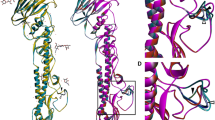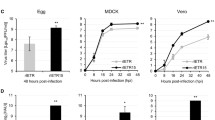Abstract
Recent isolations of H5N2 subtype avian influenza (AI) viruses in North America have raised questions concerning their origin, transmission to commercial poultry, and potential for virulence. One ratite-origin isolate of low pathogenicity, A/emu/TX/39924/93 (H5N2), was subjected to a procedure that rapidly selects and/or amplifies highly pathogenic (HP) strains. The resulting highly virulent derivative had an altered hemagglutinin (HA) gene containing an additional six nucleotides at position 970–975 in the HA1 coding region. This resulted in an arg-lys insertion near the proteolytic cleavage site of the HA protein. The remainder of the HA sequence differed by an additional seven amino acids from the parent. The HA precursor of the derivative, but not the parent, was readily cleaved during replication in cell culture without addition of trypsin. In experimentally infected chickens, the derivative produced lesions typical of highly pathogenic avian influenza. A reverse transcriptase-polymerase chain reaction (RT-PCR) primer set was designed to amplify exclusively from molecules with the inserted six nucleotides. The set yielded product only from the selected derivative samples and not the parent. Thus, the levels of the HP variants in the parent stock were undetectable, or the insertion occurred rapidly during the selection process.
Similar content being viewed by others
References
RottR., OrlichM., and ScholtissekC., J Virol 19, 54–60, 1976.
RottR., OrlichM., and ScholtissekC., J Gen Virol 44, 471–477, 1979.
BoschF.X., GartenW., KlenkH-D., and RottR., Virology 113, 725–735, 1981.
Stieneke-GroberA., VeyM., AnglikerH., ShawE., ThomasG., RobertsC., KlenkH-D., and GartenW., EMBO J 11, 2407–2414, 1992.
HorimotoT. and KawaokaY.J., Virology 68, 3120–3128, 1994.
PhilpottM., HioeC., SheerarM., and HinshawV.S., J Virol 64, 2941–2947, 1990.
PerdueM.L., LatimerJ.W., and CrawfordJ., Virology 213, 276–281, 1995.
WebsterR.G. and RottR., Cell 50, 665–666, 1987.
DeB.K., BrownleeG.G., KendalA.P., and ShawM.W., Nucleic Acids Res 16, 4181–4182, 1988.
KawaokaY., NaeveC.W., and WebsterR.G., Virology 139, 303–316, 1984.
KawaokaY., NestorowiczA., AlexanderD.J., and WebsterR.G., Virology 158, 218–227, 1987.
WoodG.W., BanksJ., McCauleyJ.W., and AlexanderD.J., Arch Virol 134, 185–194, 1994.
WoodG.W., McCauleyJ.W., BashiruddinJ.B., and AlexanderD.J., Arch Virol 130, 209–217, 1993.
DeshpandeK.L., FriedV.A., AndoM., and WebsterR.G., Proc Natl Acad Sci USA 84, 36–40, 1987.
Kawaoka Y., Walker J.A., and Webster R.G., Proc. IIIrd Int. Symp. on Avian Influenza, Madison, Wisconsin, US Animal Health Association, 1992, pp 175–181.
SaitoT., HorimotoT., KawaokaY., SenneD.A., and WebsterR.G., Virology 201, 277–284, 1994.
PanigrahyB., SenneD.A., and PearsonJ.E., Avian Dis 39, 64–67, 1995.
Swayne D.E., Beck J.R., Perdue M.L., Brugh M., and Slemons R.D., Avian Dis submitted, 1996.
PerdueM.L., WainrightP.O., and BrughM., Virus Res 16, 137–152, 1990.
ChomzcynskiP. and SacchiN., Anal Biochem 162, 156–159, 1987.
Brugh M. and Beck J., Proc. IIIrd Int. Symp. on Avian Influenza, Madison, Wisconsin, US Animal Health Association, 1993.
HorimotoT. and KawaokaY., Virology 206, 755–759, 1995.
SmithL.M., SandersR.J., KaiserHughs P., DoddC., ConnellC.R., ReinesC., KentS.B.H., and HoodL., Nature 321, 673–681, 1986.
PerdueM.L., LatimerJ., GreeneC., and HoltP., Virus Res 34, 15–29, 1994.
PerdueM.L., Virus Res 23, 233–240, 1992.
NeiM. in MiyamotoM.M. and CracraftJ. (eds.) Phylogenetic Analysis of DNA Sequences, Oxford University Press, New York, 1991, pp 90–128.
SwoffordD. PAUP: Phylogenetic Analysis Using Parsimony, Version 3 Champaign, IL Illinois Natural History Survey, 1989.
BrughM. and PerdueM.L., Avian Dis 35, 824–833, 1991.
Perdue M.L., Latimer J., Beck J., and Brugh M., Proc. IIIrd Int. Symp. on Avian Influenza, Madison, Wisconsin, US Animal Health Association, 1992, pp 211–217.
WebsterR.G., LaverW.G., AirG.M., and SchildG.C., Nature 296, 115–121, 1982.
KhatchikianD., OrlichM., and RottR., Nature 340, 156–157, 1989.
MorsyJ., GartenW., and RottR., Virology 202, 988–991, 1994.
Garcia M., Brugh M., Beck J., Swayne D., Senne D., Pearson J., Gay M., Perez-Marquex V., Toscano A., and Perdue M.L., Abstracts of the 1995 American Society for Microbiology meeting, Austin, Texas, 1995, p 108.
Author information
Authors and Affiliations
Rights and permissions
About this article
Cite this article
Perdue, M.L., Garcia, M., Beck, J. et al. An arg-lys insertion at the hemagglutinin cleavage site of an H5N2 avian influenza isolate. Virus Genes 12, 77–84 (1996). https://doi.org/10.1007/BF00370003
Received:
Accepted:
Issue Date:
DOI: https://doi.org/10.1007/BF00370003




